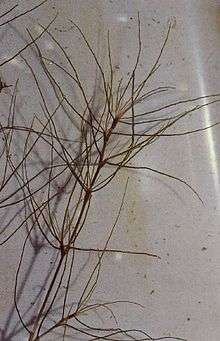Najas guadalupensis
Najas guadalupensis is a species of aquatic plant known by the common names southern waternymph,[3] guppy grass, najas grass, and common water nymph. It is native to the Americas, where it is widespread. It is considered native to Canada (from Alberta to Quebec), and most of the contiguous United States, Mexico, Central America, the West Indies and South America. It has been introduced in Japan, Israel and Palestine.[4]
| Najas guadalupensis | |
|---|---|
 | |
| Scientific classification | |
| Kingdom: | Plantae |
| Clade: | Tracheophytes |
| Clade: | Angiosperms |
| Clade: | Monocots |
| Order: | Alismatales |
| Family: | Hydrocharitaceae |
| Genus: | Najas |
| Species: | N. guadalupensis |
| Binomial name | |
| Najas guadalupensis (Spreng.) Magnus | |
| Synonyms[2] | |
| |
Najas guadalupensis is an annual, growing submerged in aquatic habitat types such as ponds, ditches, and streams. It produces a slender, branching stem up to 60 to 90 centimeters in maximum length. The thin, somewhat transparent, flexible leaves are up to 3 centimeters long and just 1 or 2 millimeters wide. They are edged with minute, unicellular teeth. Tiny flowers occur in the leaf axils; staminate flowers grow toward the end of the plant and pistillate closer to the base.[4][5][6][7][8]
Subspecies
Numerous varietal and subspecific names have been proposed. Only four are currently recognized:[2][9]
- Najas guadalupensis subsp. floridana (R.R.Haynes & Wentz) R.R.Haynes & Hellq – Alabama, Florida, and Georgia (U.S. state); naturalized in Japan[10]
- Najas guadalupensis subsp. guadalupensis
- Najas guadalupensis subsp. muenscheri (R.T.Clausen) R.R.Haynes & Hellq. – New York State[10]
- Najas guadalupensis subsp. olivacea (Rosend. & Butters) R.R.Haynes & Hellq. – Canada (Manitoba, Ontario, Quebec) and northern United States (Iowa, Minnesota, Indiana, Michigan, New York state)[10]
References
- Maiz-Tome, L. (2016). "Najas guadalupensis". IUCN Red List of Threatened Species. 2016: e.T177124A1467909. Retrieved 11 August 2020.
- The Plant List
- "Najas guadalupensis". Natural Resources Conservation Service PLANTS Database. USDA. Retrieved 16 July 2015.
- "Najas guadalupensis in Flora of North America @ efloras.org". www.efloras.org. Retrieved 2017-01-31.
- Magnus, Paul Wilhelm. 1870. Beitrage zur Kenntniss der Gattung Najas viii. Najas guadalupensis
- von, Linné, Carl; von, Linné, Carl; Christian, Dieterich, Johann; Anton, Sprengel; Anton, Sprengel; Joachim, Sprengel, Kurt Polycarp; Dieterichianae., Librariae (1825-01-01). "Caroli Linnaei ... Systema vegetabilium /". v.1 (1825). Cite journal requires
|journal=(help) - Subils, Rosa & Hunziker, Armando Theodoro. 1973.Lorentzia no. 2: 9, fig. 1, Najas arcana
- Schmidt, Otto Christian. 1925. Repertorium Specierum Novarum Regni Vegetabilis. Centralblatt für Sammlung und Veroffentlichung von Einzeldiagnosen neuer Pflanzen 22: 99, Najas urbaniana
- Kew World Checklist of Selected Plant Families, genus Najas
- Haynes, Robert Ralph & Hellquist, C. Baare. 1996. New combinations in North American Alismatidae. Novon 6(4): 370-371
